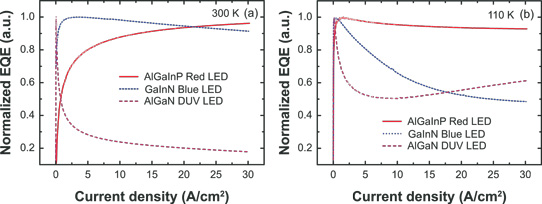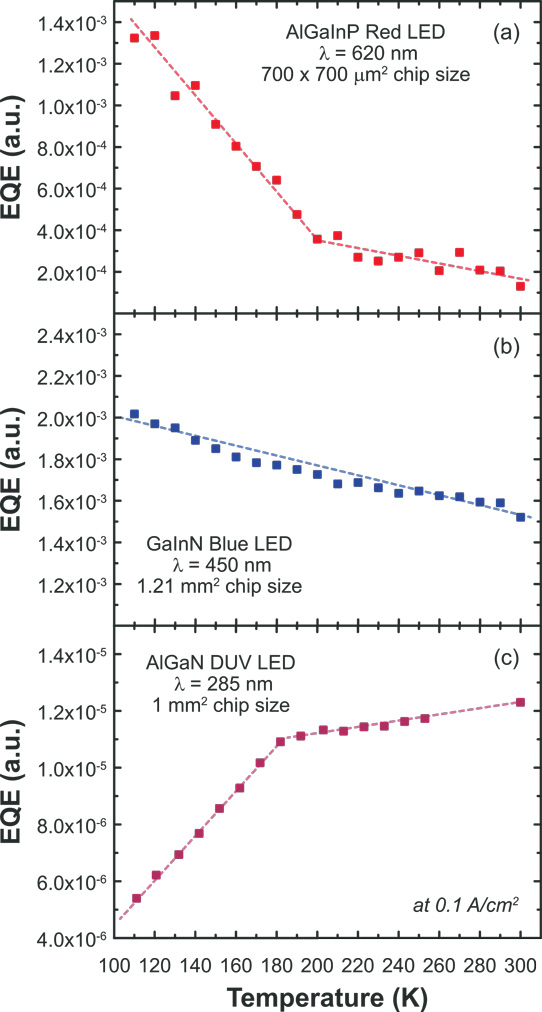- News
3 February 2016
Taking temperature of light-emitting diode external quantum efficiency
Researchers based in Korea and USA have been studying the temperature dependence of external quantum efficiency (EQE) for a range commercial light-emitting diodes (LEDs) [Jun Hyuk Park et al, J. Appl. Phys., vol119, p023101, 2016]. The team sought to disentangle the various effects that impact LED performance such as non-radiative Shockley-Read-Hall (SRH) recombination and carrier freeze-out.
SRH recombination through mid-gap states reduces efficiency at higher temperatures. By contrast, carrier freeze-out is a low-temperature factor.
The III-nitride compound semiconductors suffer particularly from high activation energies for the acceptor states that create p-type conduction through hole transport (Table 1). These activation energies are more severe in the wide-bandgap semiconductors needed for shorter-wavelength radiation. This factor leads to an imbalance between the hole and electron concentrations.
|
Donor |
Acceptor |
AlInP |
80meV |
76meV |
GaN |
15meV |
170meV |
AlN |
62meV |
630meV |
Table 1: Typical activation energies for electron donor and acceptor impurities.
The researchers - from Pohang University of Science and Technology (POSTECH), Chonbuk National University, Rensselaer Polytechnic Institute in the USA, and Samsung Electronics - characterized 620nm red aluminium gallium indium phosphide (AlGaInP), 450nm blue gallium indium nitride (GaInN), and 285nm deep-ultraviolet aluminium gallium nitride (AlGaN) LEDs.
The epitaxial materials for these devices were derived from metal-organic chemical vapor deposition (MOCVD). The active regions were multiple quantum wells: 38-period AlGaInP/AlInP, 5-period GaInN/GaN, and 5-period AlGaN/AlGaN.
Characteristics were measured under pulsed current injection to avoid self-heating of the devices.
The EQE was measured at a range of temperatures. At room temperature (300K), there was no efficiency droop before 30A/cm2 for the red device, while the blue and DUV LEDs showed droops of 8.6% and 82.1%, respectively, at 30A/cm2 (Figure 1). Lowering the temperature to 110K created a small droop of 7.1% for the red LED. The blue device had an increased droop of 48.8%.

Figure 1: Normalized EQE curves as a function of current density for AlGaInP red LED, GaInN blue LED, and AlGaN DUV LED measured at (a) 300K and (b) 110K.
The AlGaN LED at 110K had a minimum EQE at 10A/cm2 and then increased to give a droop of 38.8% on the initial peak at 30A/cm2.
The researchers comment: "The AlGaN DUV LED has an intrinsically large asymmetry in carrier concentration at cryogenic temperatures, so that the EQE initially decreases (droop), then reaches an EQE minimum point (minimum of 'U-shape'), and then increases again due to the field-ionization of acceptors by the Poole-Frenkel effect."
The Poole-Frenkel effect describes how, under an applied field, acceptor impurities ionize more easily, increasing hole concentration. The DUV LED also had a different temperature behavior under low current injection (Figure 2), with an increase rather than decrease at higher temperature.

Figure 2: Temperature-dependent EQE curves for (a) AlGaInP red LED, (b) GaInN/GaN blue LED, and (c) AlGaN DUV LED measured at 0.1A/cm2.
The researchers comment: "the experimental data indicate that, for the AlGaInP red LEDs, the effect of SRH recombination on EQE is stronger compared to the effect of hole freeze-out. That is, the effect of asymmetry in carrier concentration is relatively smaller for the AlGaInP red LED. On the contrary, in the AlGaN DUV LEDs, the effect of hole freeze-out is stronger than that of SRH recombination due to the larger acceptor activation energy and the resulting larger carrier asymmetry."
LEDs Red AlGaInP LEDs GaInN LEDs DUV AlGaN LEDs MOCVD
http://dx.doi.org/10.1063/1.4939504
The author Mike Cooke is a freelance technology journalist who has worked in the semiconductor and advanced technology sectors since 1997.


